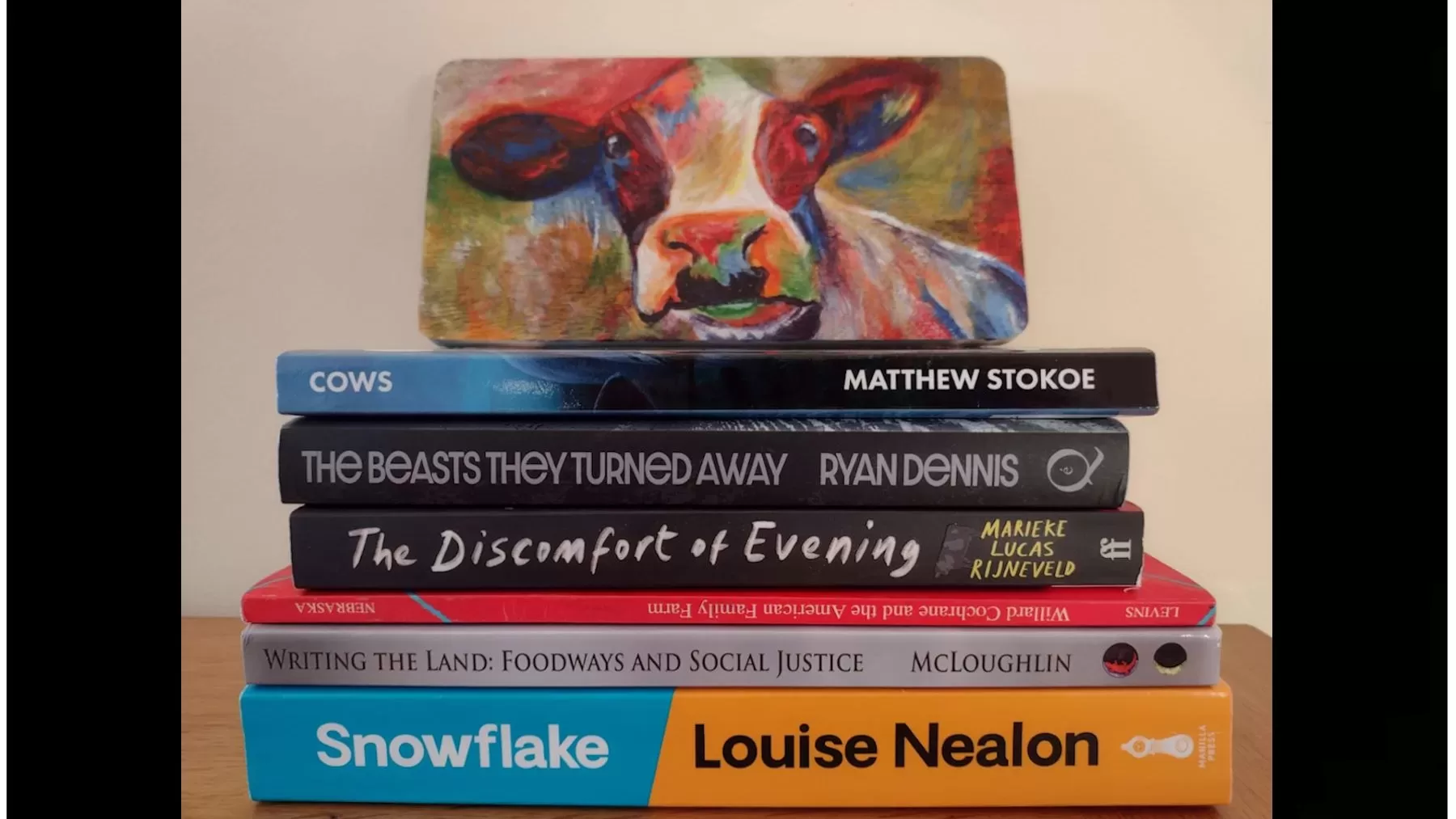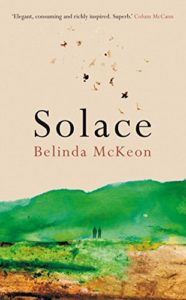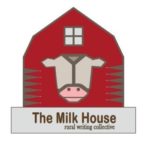Farming is an essential part of the human story. Although the number of farmers is declining world wide, many people still have family members who farm or once did, while others are still directly connected to agriculture. Farming is a unique lifestyle that is as specific as it can be challenging, and therefore the natural source of many types of stories. With that in mind, we’ve curated (and continue to add to) this collection of farm books, with 114 entries and counting.
This list of farm books includes fiction (novels and short story collections), memoirs, and books that focus more on relaying a specific point (factual), recognizing that the latter two categories can be hard to distinguish at times. You’ll notice that we glibly call all of the examples below farm books, even though at times the term may fall too broadly. We also haven’t included poetry.
Another inherent difficulty in creating such a list, as one might expect, is determining what constitutes a “farm book.” While in some novels the protagonist’s autonomy is dependent on a farm they’re connected to, in other instances it factors into the story in lesser degrees. Trying to avoid being too finicky, we’ve attempted to include books in which the farm is more than in background and typically has characters or narrators carrying out actual acts of farming.
While a variety of countries are listed (in alphabetical order), we’ve only included farm books in which there is a known English translation.
Finally, we view this project as collaborative and always in progress. If you know of a farm book not on this list then please leave a comment below or use this contact form with the heading “Farm Books.”
Denmark
Fiction
Nexø, Martin Anderson. Pelle the Conqueror. 1910
Lasse Karlsson and his son Pelle leave southern Sweden for the island of Bornholm in Denmark after the death of Pelle’s mother. They find work on a large farm and work there, despite Pelle being young and Lasse being an old man. To get by, they must survive the mistreatment and drama common to the estate.
Iceland
Fiction
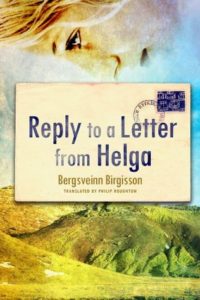 Birgisson, Bergsveinn. A Reply to Helga’s Letter (Svar við bréfi Helgu). 2010
Birgisson, Bergsveinn. A Reply to Helga’s Letter (Svar við bréfi Helgu). 2010
As an old man, Bjarni looks back at his life and his two loves: his farm and neighbor’s wife, Helga. Ultimately, he had to choose one. This novel is his explanation.
Laxness, Hálldor. Independent People (Sjálfstætt fólk).1934
Laxness’ epic is a source of national pride in Iceland. Bjartur of Summerhouses struggles his whole life to be an independent farmer with his own land, a desire that he follows relentlessly regardless of the consequences to those around him.
India
Fiction
Markandaya, Kamala. Nectar in a Sieve. 1954
At the age of 12 Rukmani is arranged to be married to a tenant farmer named Nathan. Despite being in a loving relationship, Rukmani faces one difficulty after another and must find ways to endure.
Ireland
Fiction
Bell, Sam Hanna. December Bride. 1951
One of the few farm books that show actual scenes of farming, Bell’s novel was daring for the times. In defiance of a tight-knit Presbyterian community in turn-of-the-century Northern Ireland, two brothers and one woman live together in committed love relationships.
Gilligan, Ruth. The Butcher’s Blessing. 2020
Also appearing under the title The Butchers, this story details the clash between folklore and modern skepticism. The novel chronicles the reactions of the family of one of the eight “butchers,” men who travel from farm to farm to enact ancient slaughter rituals on cattle.
Read a review of The Butcher’s Blessing.
Dennis, Ryan. The Beasts They Turned Away. 2021
Íosac Mulgannon is trying to keep his farm and his sanity, while attempting to care for a small boy who is mute and may be cursed. This lyrical gothic novel confronts the changes in modern agriculture.
Kavanagh, Patrick. Tarry Flynn. 1948
Based on Kavanagh’s own experience growing up on a farm, this farm book chronicles a young man weighing what he loves about an agricultural existence against what he might be missing out on. Tarry Flynn was removed by the Irish Censorship Board for being “indecent and obscene” and did not return to print until the 1960s.
Keegan, Claire. Foster. 2010
In Keegan’s novella, a young girl stays with a childless farming couple, eventually learning that they have a secret. In 2022 it was turned into the Irish-language film An Cailín Ciúin (The Quiet Girl).
McCabe, Eugene. Heritage and Other Stories. 1978
Set in the border counties during the time of the troubles, a farmer tries to live in peace despite the violence that is threatened upon him.
McCabe, Eugene. Death and Nightingales. 1992
Set in 1883, Beth Winters seeks to avoid making the same mistakes as those in her family’s past. In 1998 it was made into a BBC miniseries. Being a dairy farmer himself, McCabe’s novel contains some of the most authentic farming scenes found in Irish fiction.
McGahern, John. That They May Face the Rising Sun. 2001
His final book, That They May Face the Rising Sun is a departure from McGahern’s earlier anti-pastorals, presenting an idyllic Irish countryside full of small farmers and where most drama is offscreen. Some scholars suggest the novel was a eulogy to a changing rural landscape.
McGahern, John. Amongst Women. 1990
Set on a small farm in County Leitrim, Amongst Women is likely McGahern’s best known work, being shortlisted for the Booker Prize and winning The Irish Times/Aer Lingus Literary Award. The novel follows Michael Moran and the relationship with his children, who both love and fear him.
A father and son try to figure each other out after a sudden tragedy upends their world. Within this novel is the age-old conflict of a farmer’s expectation of their children in regard to the farm.
Nealon, Louise. Snowflake. 2021
Snowflake is a story of a farmgirl entering Trinity College in Dublin, trying to find her place in the world while at the same time negotiating the demons of others. It received the An Post Newcomer of the Year award.
O’Flaherty, Liam. Famine. 1937
O’Flaherty’s novel tells the story of three generations of Kilmartins trying to survive the Great Famine in the 1840s.
Ryan, Donal. The Spinning Heart. 2012
Not inherently a “farm book,” this short novel chronicles a small town in the wake of a recession through multiple viewpoints. (Included because there are two scenes of cows being milked.) The Spinning Heart was Ryan’s debut and widely acclaimed.
Ryan, Donal. The Thing about December. 2013
Set after the Celtic Tiger, the book follows 24-year-old Johnsey Cunliffe’s attempt to keep pace in a society that is moving too fast for him. Having inherited a farm worth millions makes it even harder to negotiate a greed-centered world.
Taylor, Marilyn. Faraway Home. 1999
This young adult farm book, based on a true story, includes two Jewish children from Nazi-occupied Austria being sent to a refugee farm in Northern Ireland.
Memoir
Connell, John. The Cow Book. 2017
One of the bestselling literary books in Ireland the year of publication, The Cow Book follows the year after the author returns to the family beef farm. The memoir covers both the difficulties of farming, as well as the complications that sometimes arise between a father and a son on a farm.
Cunningham, PJ (Editor). Around the Farm Gate. 2015
The collection of 50 stories, mostly from Irish farmers themselves, helps to chronicle the Irish farming past. It includes tales detailing the hardships, as well as humor, of trying to farm in Ireland.
Read a review of Around the Farm Gate.
Cunningham, PJ. The Lie of the Land. 2013
Cunningham tells of his childhood on an Irish farm through a collection of 18 essays.
Cunningham, PJ. The Long Acre. 2014
This farm book portrays the struggles and ambitions of a previous generation in Ireland in a moment during which they stand at the crossroads between the old and modern.
Cunningham, PJ. A Fly Never Lit. 2015
The third book in a trilogy of memoirs, this project looks specifically at rural Irish life in the 1960s and 1970s. It traces the transition of a changing Ireland.
Kavanagh, Patrick. The Green Fool. 1938
This childhood memoir paints life in rural Ireland in the early 1900s, with Kavanagh’s boyhood exploits providing humor, as well as a look into the beginnings of one of the island’s famed poets.
McElhone, Maura. Falling for a Farmer. 2018
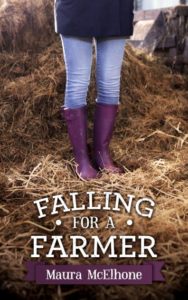 McElhone is suddenly thrust into a farm family as she dates and then marries a farmer in County Kildare. Described as ” Bridget Jones’s Diary meets All Creatures Great and Small,” this book shows both the humorous and sobering experiences in adapting to farm life for the first time. Read her essay on The Milk House here.
McElhone is suddenly thrust into a farm family as she dates and then marries a farmer in County Kildare. Described as ” Bridget Jones’s Diary meets All Creatures Great and Small,” this book shows both the humorous and sobering experiences in adapting to farm life for the first time. Read her essay on The Milk House here.
McGahern, John. Memoir. 2005
Detailing some of the most influential moments in his life, readers of McGahern will recognize some of the images in his fiction. Some memories involve the farm he grew up on in Knockanroe.
Sixsmith, Lorna. Till the Cows Come Home. 2018
Lorna and her husband start milking on her family’s ancestral farm at Garrendenny in County Laois. Sharing the insight and wisdom hard earned in working with dairy cattle, Lorna frames the modern agricultural experience in Ireland and makes it accessible for those who don’t farm. Read her piece on The Milk House here.
Read a review of Till the Cows Come Home.
Factual
Bell, Jonathan and Watson, Mervyn. Irish Farming Life: History and Heritage. 2014
Bell and Watson’s analysis deconstructs the social, economic and cultural mechanism at work in Irish farming, including topics such as neighborly ties and the use of hired labor. The abundancy of illustrations make it an enjoyable read for the academic and layman alike.
Grene, Nicholas. Farming in Modern Irish Literature. 2021
This study traces farm books and the representation of agriculture in Irish literature since 1922. Its analysis is easily digestible for laymen, while still being a valuable resource for the academic.
The Netherlands
Fiction
Bakker, Gerbrand. The Twin (Boven is het stil). 2009 (2006)
The narrator’s twin brother, whom his father preferred, had died. The narrator is left to carry on the dairy farm and take care of his invalid father while trying to reconcile how he actually wants to live his life. The novel received the International Dublin Literary Award in 2010, the first time it had been won by a Dutch author.
Rijneveld, Marieke Lucas. The Discomfort of Evening (De avond is ongemak). 2018
Winner of the International Booker Prize, Rijneveld’s young female protagonist loses her brother after he falls through the ice on the lake. Set on a dairy farm in the Netherlands, each member of the family struggles with surviving the loss and the difficulties of farming.
New Zealand
Fiction
Devanny, Jean. The Butcher Shop. 1926
Originally banned in New Zealand for being “indecent,” this fast-paced book follows a rich and cultured farm family unravelling through jealously. With new printings, Devanny’s farm book is now being hailed for being ahead of its time in promoting freedom for women.
Hawkins, Danielle. Dinner at Rose’s. 2012.
Hawkins, who is a large animal vet and lives on a farm, tells the story of Jo, a woman that leaves the city after finding her boyfriend having sex with her best friend. She ends up spending time with her eccentric Aunt Rose on her farm, and eventually must help keep the farm going.
Hayton, Katherine. The Three Deaths of Magdalene Lynton. 2018
Teenager Magdalene Lynton accidentally drowns in a farm tank. Forty years later, cancer-stricken Paul Worthington confesses to her rape and murder. However, the story doesn’t add up.
Orr, Sue. The Party Line. 2015
Set in a New Zealand farming community in the 1970s, this novel follows sharemilkers moving from farm to farm in the quest of owning their own land someday. A coming-of-age story of two girls, the story explores what it means to be caught in a moral dilemma.
Sussman, Fiona. The Last Time We Spoke. 2016
A family’s peaceful existence on a farmstead is upheaved when a gang member breaks into their house. This farm book and crime novel deals with the aftermath of the event and the weaving stories of the characters.
Thomas, Rhydian. Milk Island. 2017
This humorous and satirical novel is set six years in the future from its publication date (2023), after New Zealand has been turned into a vast “agri-prison” complex. Absurd and over the top, this farm book looks to criticize the country’s government and their handling of agriculture.
Read a review of Milk Island.
Norway
Fiction
Wassmo, Herbjørg (translated by Nadia Christensen). Dina’s Book. 2013
Blamed for her mother’s death, Dina is banished to a farm by her father, where she grows up wild and untamed. Set in mid-19th century Norway.
South Africa
Fiction
Coetzee, J.M. Disgrace. 1999
Winner of the Booker Prize, Disgrace helped Coetzee win the Nobel Prize four years later. When David Lurie’s life falls apart due to bad decisions, he seeks refuge on his lesbian daughter’s farm. When that farm is attacked, he and his daughter must deal with the aftermath.
Schreiner, Olive. The Story of an African Farm. 1883
First appearing under the pen name Ralph Iron, The Story of an African Farm is considered one of the first feminist novels. Written during the era of first-wave feminism, the protagonist Lyndall’s refusal to participate in societal norms (such as marrying the father of her child) was ahead of the time.
Sweden
Fiction
Smith, Tom Rob. The Farm. 2013
This farm book is first a crime thriller. Set in a patriarchal farming village, a detective must uncover what has happened to a vulnerable young woman.
Strindberg, August. The People of Hemsö (Hemsöborna). 1887
The wealthy widow Mrs Flod hires the protagonist Carlsson to run her farm, which has been neglected. The locals must decide if Carlsson is honest in his intentions on the island.
United Kingdom
Fiction
Chatwin, Bruce. On Black Hill. 1982
Winner of the James Tait Black Memorial Prize, the novel follows the lives of two Welsh twins Lewis and Benjamin Jones. The twins deal with the sometimes harsh realities of farming and feelings of wanting to break away, one twin wanting freedom while the other feels close ties the land.
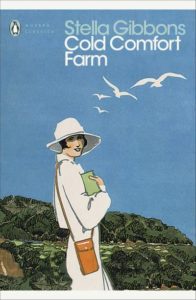 Gibbons, Stella. Cold Comfort Farm. 1932
Gibbons, Stella. Cold Comfort Farm. 1932
Parodying novels of the time that cast rural life as backwards, downtrodden and ignorant, Gibbon’s Flora Poste goes to live with her farming relatives because she is unable to support herself financially. Flora solves the problems of her relatives by bringing her levelheaded common sense and metropolitan values.
Hardy, Thomas. Far from the Madding Crowd. 1874
Set in a Victorian farming community in Wessex, the bold Bathsheba Everdene arrives in Weatherbury to take up her position as a farmer on the largest estate in the locale, and in doing so draws the attention of three potential suitors.
Harrison, Melissa. All Among the Barley. 2018
Winner of the EU Prize for Literature, this farm book is set in 1933. Edie Mather befriends an older woman named Constance FitzAllen, who may not be what she seems.
King-Smith, Dick. The Sheep Pig. 1983
Also known as Babe, the Gallant Pig in the US, this beloved children’s novel hit international acclaim with its 1995 movie adaption. Who hasn’t shouted “Ba-Ram-Ewe”?
Raisin, Ross. God’s Own Country. 2008
Shortlisted for nine literary awards, this farm book tells the story of a solitary young farmer, Sam Marsdyke. Ostracized by the rest of the world, Marsdyke is a loner until he meets rebellious new neighbour Josephine, after which the story gets darker.
Wodehouse, P. G. Love Among the Chickens. 1906
One of Britain’s favorite 20th century humorist, Wodehouse’s novel is told by Jeremy Garnet, who is taken on a holiday on a chicken farm and gets firsthand experience of the struggles of the farm, and in the meantime tries to impress a girl.
Memoir
Herriot, James. If Only They Could Talk. 1970
Note: James Herriot’s books are listed as they appeared originally in the UK, not how they were published in the US.
The first book from James Alfred Wight, the man behind the pen name James Herriot, Herriot is a newly qualified veterinarian. The story follows his adventures upon first arriving in the small Yorkshire village of Darrowby.
Herriot, James. It Shouldn’t Happen to a Vet. 1972
Once again we see Herriot making the rounds of his vet practice, with encounters with his boss Siegfried Farnon and a beautiful woman named Helen.
Herriot, James. Let Sleeping Vets Lie. 1973
Now with two years of experience behind him, Herriot still feels lucky to be working on the Yorkshire moor as a vet.
Herriot, James. Vet in Harness. 1974
Now married, Herriot still brings to life his humorous encounters with the farmers and animal owners he served.
Herriot, James. Vets Might Fly. 1976
World War II forces Herriot to leave his life as a veterinarian to serve in the RAF, although he wishes to be back with the animals again.
Herriot, James. Vet in a Spin. 1977
Still working for the RAF, Herriot dreams of returning to his old profession, and hopes the RAF agrees.
Herriot, James. The Lord God Made Them All. 1981
Now home from the Royal Airforce, Herriot returns to his practice and brings more delightful and warming stories of his encounters.
Herriot, James. Every Living Thing. 1992
The last book in the series, Herriot treats cases such as Calum Buchanan’s badgers, strange cats, and a dog that gives him fleas.
Langord, Sara. Rooted: Stories of Life, Land and a Farming Revolution. 2022
Sara returns to her agricultural roots after working in the city as a barrister, and finds new challenges facing farmers, as well as new ways they are dealing with them. This farm book provides a human side to modern farming.
Rebanks, James. English Pastoral: An Inheritance. 2020
Rebanks shares his childhood growing up on a farm in the Lake District, as well as the regenerative farming practices he employs as a farmer himself. This bestseller was also honored with the Sunday Times Nature Book of the Year.
Young, Rosamund. The Secret Life of Cows. 2017
Young gives anecdotes about the cattle in her herd, showing them to be thoughtful, intelligent creatures with more complicated needs than we give them credit for.
United States
Fiction
Berry, Wendell. Nathan Coulter. 1960
His first novel, published at the age of 27, introduces Port William, a place often returned to in Wendell’s work. The titular character lives on a farm and finds much of his autonomy there.
Berry, Wendell. The Memory of Old Jack. 1974
Retired farmer “Old Jack” Beechum looks back at his life and the forces that shaped it.
Berry, Wendell. Remembering. 1986
Perhaps one of the farm books that most directly addresses agricultural policy, Andy Cartlett tries to find himself again after losing his hand in a farm accident.
Berry, Wendell. Stand by Me. 2019
This collection of stories by the 80-plus prolific chronicler of rural life features characters who are trying to make a marginal farm work.
Bromfield, Louis. The Farm. 1933
Louis Bromfield has an interesting biography, being a writer-turned-farmer and a pioneer in sustainable farming in the methods in the US. Agriculture predominated much of this thinking in later life, The Farm being written just before Bromfield returned to America after decades of living in France. Following a farming family in Ohio, the novel suggests the deleterious affect of industrial agriculture on American farming culture.
Buck, Pearl S. The Good Earth. 1931
The daughter of American missionaries in China, book’s third book in her House of Earth trilogy won the Pulitzer Prize in 1932 and helped earn her the Nobel Prize in 1938. The story dramatizes the story of Chinese farmers trying to improve their fortunes from a small farm.
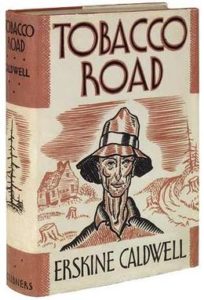 Caldwell, Erskine. Tobacco Road. 1932
Caldwell, Erskine. Tobacco Road. 1932
This acclaimed book about poor white Georgia sharecroppers in the Great Depression was made into a Broadway play, adapted to a movie by John Ford, and was ranked in the 100 best English-language novels of the 20th century by the Modern Library in 1998. Jeeter Lester is not a good man, but one who loves to farm.
Cather, Willa. O Pioneers!. 1913
Alexandra Bergson loves the farm, and upon inheriting it after her father’s death, makes sacrifices to keep it going. The book also centers around two love relationships, both of them complicated.
Cather, Willa. My Ántonia. 1918
Considered Cather’s breakthrough novel, Jim Burden is an orphaned boy brought to the Nebraska prairie who friends Ántonia, the daughter of Czech immigrants. Jim tells the story of their friendship, as well as Ántonia’s struggle to keep her farm going.
Frederic, Harold. Seth’s Brother’s Wife. 1887
This early depiction of farm life in Upstate New York is bleak, showcasing a community in ruin and a lifestyle under threat. Seth Fairchild eventually moves to the city, however, to find life complicated there as well.
Garland, Hamlin. Main-Travelled Roads. 1891
In terms of fiction, Main-Travelled Roads is largely thought to be one of the first American farm books. This collection of semi-autobiographical short stories portray some of the harsher realities of agrarian life in the northwestern prairie states.
Garland, Hamlin. Jason Edwards: An Average Man. 1892
From perhaps the earliest writer of American farm books, Jason Edwards is divided into two parts, one that portrays the Edwards’ family’s discontent in the city (The Mechanic), and other showing their struggles to keep a farm financially stable (The Farmer).
Grisham, John. A Painted House. 2001
One of the more commercial farm books on the list, A Painted House represents Grisham’s first departure from legal thrillers. Drawing on his own childhood in Arkansas, the story is told through the perspective of seven-year-old Luke Chandler as his family tries to support themselves with a cotton crop.
Hannah, Kristin. The Four Winds. 2021
Set during the Great Depression, Elsa must choose between fighting for the land she loves, or heading west to California with many of her neighbors.
Norris, Frank. The Octopus: A Story of California. 1901
One of the earliest examples of farm books, as well as an early indictment on industrial agriculture, Norris’ novel details the conflict between wheat growers and the railroad. It was inspired by the Mussel Slough Tragedy in 1880.
Smiley, Jane. A Thousand Acres. 1991
Thanks, in part, to winning the Pulitzer Prize and National Book Award, A Thousand Acres is probably one of the most well known farm books on the list. A retelling of King Lear set on a crop farm in Iowa, the novel is told through the point of view of Ginny, the oldest of three daughters to an aging farmer.
Read a review of A Thousand Acres.
Smiley, Jane. Some Luck. 2017
Set on a farm in Denby, Iowa, the Langdon family experiences the triumphs and setbacks of life across several generations.
Steinbeck, John. The Grapes of Wrath. 1939
Often one of the first novels thought of when it comes to farm books, this enduring classic won the Pulitzer Prize, National Book Award, and was largely responsible for getting Steinback the Nobel Prize in 1962. Paramount among Great Depression stories, the plight of Joad family commented on the American dream.
Stokoe, Matthew. Cows. 2015
The weirdest, most bizarre of all the farm books here…by far. If you like a novel that pushes the boundaries of the grotesque, while still being solid writing, this is your bag. Talking cows, sex with alive cows, sex with dead cows, eating human feces. Just don’t say that you weren’t warned.
Tester, William. Darling. 1991
Recommended on our list of 10 Farm Novels for Winter Reading, Tester’s skill as a writer makes even the most absurd and grotesque circumstances feel plausible and innately human. In Darling, two brothers meet as adults and remember competing for the sexual attention of a beloved cow. Perhaps best described as a book that rewards the daring reader.
Tester, William. Head. 2000
Most of the eleven stories in Head are not agriculturally-related, but all of the stories are excellent. The first story, “Wet,” is set on a dairy farm in the swamplands of Florida, and is enough reason to pick up the collection for those looking for farm-based fiction.
Updike, John. Of the Farm. 1965
Considering the number of novels that John Updike wrote, it is not surprising that at least one of the is set on a farm. Different than other farm novels on this list, as the farm in question is unworked, the story follows a son’s anger at his mother for refusing to leave the land.
Weaver, Will. Red Earth, White Earth. 1986
Weaver’s debut novel ambitiously tackles a complicated subject. Guy Pehrsson returns to his father’s dairy farm while his childhood friend,Tom Little Wolf, is attempting to reclaim the former land of his native Ojibwe tribe that is now owned by white farmers.
Weaver, Will. A Gravestone Made of Wheat and Other Stories. 1989
This collection of short stories bring to life rural Minnesota and the people that made a life there. The title story was made into the movie Sweet Land in 2005. Some stories may be among some of the most authentic writing about farming to date.
Weaver, Will. Sweet Land. 2006
Following the premier of the movie by the same name (but actually based on a story in the collection A Gravestone Made of Wheat), Weaver includes new and previously published stories.
Wharton, Edith. Ethan Frome. 1911
One of the older farm novels on the list, the story feels both classic and yet current somehow. Ethan cares for this his sickly wife Zeena, who often berates him, while also managing the farm. When they take in Mattie, his wife’s cousin, to help around the house, a forsaken affection develops between the two.
White, E.B. Charlotte’s Web. 1952
E.B. White had an illustrious career, from writing for The New Yorker and co-authoring the famous English language style guide The Elements of Style. However, perhaps his most enduring work is Charlotte’s Web, which in a 2012 survey of School Library Journal readers came first in a poll of most liked children’s novels.
Wilder, Laura Ingalls. Farmer Boy. 1933
Technically the second books in the Little House series, Farmer Boy is not connected to the children’s novels that precede or follow after it. The book portrays the childhood experiences of Wilder’s husband Almanzo, who grew up on a farm in Malone, NY.
Williams, Jonathan. Stoner. 1965
Although the only actual farming in this novel occurs in the beginning, it does feature a farmer’s son who chooses academia over farming, and more than that, is a great book. (Hence it has a deserving spot on this list of best farm novels.) This touching and powerful story explores how one faces the disappointments in their life.
Wilson, Diane. The Seed Keeper. 2021
Rosalie Iron Wing, from the Dakhóta people, spent two years on her white husband’s farm before returning to her childhood home. Following the struggling of protecting the farm against drought and multinationals, Rosalie confronts her past and heritage.
Memoir
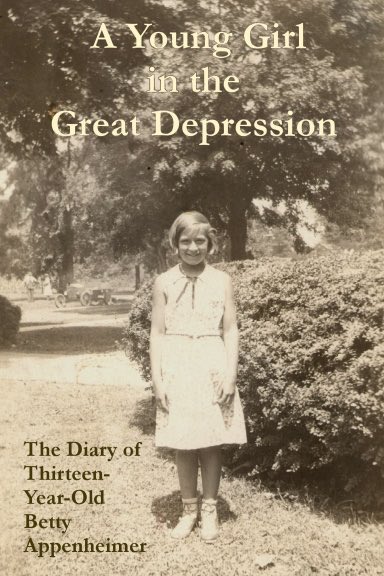 Appenheimer, Betty. A Young Girl in the Great Depression. 2019
Appenheimer, Betty. A Young Girl in the Great Depression. 2019
Appenheimer skillfully chronicles the years 1934-1936 and provides insight into how a Midwestern farm tried to survive the Great Depression.
Bromfield, Louis. Pleasant Valley. 1945
Bromfield writes about his farming experiences at his Malabar Farm in Ohio, sharing some of the pioneering regenerative agricultural practices that he implemented.
Read a review of Pleasant Valley.
Garlin, Hamlin. A Son of the Middle Border. 1917
Championed as a classic American realism, Garland might be less known than other practitioners, but deemed by many as no less important. A Son of the Middle Border depicts Garlin as a farmboy engaging with the Midwest’s beauty and brutalism.
Hulse, Dean. Westhope: Life as a Former Farmboy. 2009
This collection of essays shares Hulse’s experience of growing up in a North Dakota farming community in the 1960s and 1970s. He calls an idyllic childhood that is very much different to what the small towns around him look like now.
Kline, David, Great Possessions: An Amish Farmer’s Journal. 1990
Different than many other farm books, this memoir gives the perspective of an Amish farmer and gives us an insight into his lived experience.
Kline, David. The Round of a Country Year: A Farmer’s Day Book. 2017
In this farm book, Kline records the everyday life and practices on his organic farm. With an acute ecological lens, he brings to life the the joys and challenges of smallscale farming.
Larkin, David. Farm: The Vernacular Tradition of Working Buildings. 1998
This illustrated table book farm buildings being saved and restored, as well as includes the stories and anectdotes of the people connected to them.
MacDonald, Betty. The Egg and I. 1945
This humorous memoir might feel dated to a modern audience, but does serve as a time capsule of the forties. Macdonald reveals her experiences in starting a chicken farm with her husband. This farm book was later turned into a film.
Factual
Berry, Wendell. The Long-Legged House. 1969
Berry’s ultimate strength, in my opinion, lies in his nonfiction and being willing to defend small farming before it was culturally or politically popular to do so. This is his first of many essay collections that often return to the same ideas tying ecology and community together.
Berry, Wendell. A Continuous Harmony: Essays Cultural & Agricultural. 1972
With the often-cited “Think Little” and other essays, Berry suggests that small farming is better for the health of the individual and the community.
Berry, Wendell. The Unsettling of America: Culture and Agriculture. 1977
One of the earliest major calls against agribusiness, this collection has become a classic. It’s listed as one of The Milk House’s Five Books about Farming that Explain the Industry.
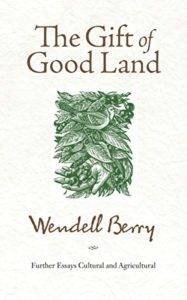 Berry, Wendell. The Gift of Good Land: Further Essays Cultural and Agricultural. 1981
Berry, Wendell. The Gift of Good Land: Further Essays Cultural and Agricultural. 1981
Berry insists on the interconnectedness of people and land, and calls on us to be good stewards of the planet.
Berry, Wendell. Standing on Earth: Selected Essays. 1991
Not as well known as other collections, Standing on Earth also includes a forward by Jonathan Porritt.
Berry, Wendell. The Art of the Commonplace: The Agrarian Essays of Wendell Berry. 2002
This collection contains some of Berry’s most influential essays.
Berry, Wendell. Bringing It to the Table: On Farming and Food. 2009
“Eating is an agriculture act,” Berry writes. Tracing the origins of food, he admonishes us to consider where our food comes from and how it was produced.
Berry, Wendell. It All Turns on Affection: The Jefferson Lecture and Other Essays. 2012
In a lecture delivered for the National Endowment Endowment for the Humanities, Berry traces the how the experience of the small farmer has changed and what that means for the rest of us.
Read a review of It All Turns on Affection.
Berry, Wendell. The Art of Loading Brush: New Agrarian Writings. 2017
If you think that Berry is prolific, keep in mind that the novels and essays collections that are not explicitly farm books are not included in this post, nor all of his poetry.
Freyfogle, Eric T., ed. The New Agrarianism: Land, Culture, and the Community of Life. 2001
This collection of essays includes the work of a variety of writers addressing a new future for agriculture, including Berry and Logsdon. Among other things, the book argues that agrarianism is more than what is produced, but also the way farming practices are integrated into our lives.
Hagenstein, Edwin C., ed. American Georgics: Writings on Farming, Culture, and the Land. 2011
One of the most recognized academic farm books in the last few decades, this collection of essays comprehensively traces agrarian ideals through the nation’s history.
Logsdon, Gene. Living at Nature’s Pace: Farming and the American. 1980
With a forward from Wendell Berry, Living at Nature’s Pace follows on from Berry’s work, arguing for sustainable agricultural methods rather than industrial farming.
Logson, Gene. The Contrary Farmer. 1995
Arguably foretelling the rise of civic agriculture, Logsdon uses his own experience to suggest how “cottage farming” can lead to a productive and ecologically sound living.
Jackson, Wes, Berry, Wendell and Bruce Colman. Meeting the Expectations of the Land: Essays in Sustainable Agriculture and Stewardship. 1986
Wendell Berry teams up with his mentor Wes Jackson and Bruce Colman to further explore sustainability.
Salatin, Joel. Folks, This Ain’t Normal: A Farmer’s Advice for Happier Hens, Healthier People, and a Better World. 2011
Joel Salatin, one of the famous farmers in the United States due to his books on agricultural sustainability, makes the philosophical and scientific case for returning to the land with small farming and the simple joy that comes from it.
Ryan Dennis is the author of the novel The Beasts They Turned Away, available internationally.
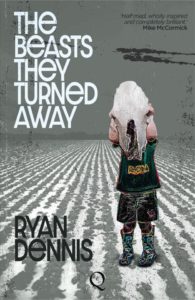 Íosac Mulgannon is a man called to stand.
Íosac Mulgannon is a man called to stand.

